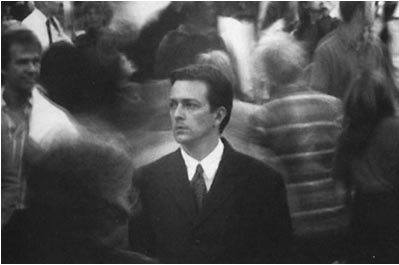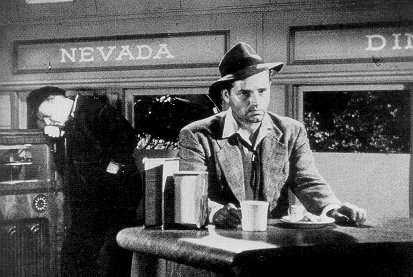
OK, so even though I watched Following (1998) this past weekend, I'm still not a Christopher Nolan compleatist: I haven't seen his three-minute student short, Doodlebug (1997). But that's all right: I have seen Memento (2000), his 2002 remake of Insomnia, and Batman Begins (2005). (For the upcoming The Prestige, you can go here on the Internet Movie Database for general plot and cast information; looks like strange doin's.) And so in true Memento fashion, I've watched his first feature film last, so that it is following while I follow his films. If you follow me. (Sorry.)
After those first two movies, it seems Nolan gave up on non-linearity. But without going into detail about his second two films, it's obvious he remains hooked on the mysterious effect of time and circumstance, whether it's in Bruce Wayne's past-present loop, trapping him almost fatally in his misapprehension of the past, and need to re-configure his present; or Detective Will Dormer's (Al Pacino) time-blurring insomnia, leading him into a blinding whiteout future that reveals his past. In both of these films the past judges, then instructs, then either saves or ruins.
Following anticipates the mysteries of his last two films and the blank walls of Memento in a neo-noir whose black-and-white London seems claustrophobically enclosed--with choices, to be sure, but all of them leading down. The protagonist, Bill (Jeremy Theobald), a would-be writer, follows people around the city, playing by careful rules that he of course breaks, and is confronted by one of his subjects, Cobb (Alex Haw), who leads him to a lonely place indeed, with "The Blonde" (Lucy Russell) as Bill's femme fatale. Eventually, it becomes a triple-cross Double Indemnity (1944) without Walter Neff's (Fred MacMurray) steady job. Instead, Following's investigator is a half-smart double patsy, in a plot that in the end may be more interested in its twists and turns than its characters, most of whom it doesn't even bother to name, but still provides icy-good fun.
 What I like best about Follwing, though, is its student-project handmade quality. It felt unrushed but spare, a carefully crafted film with limited resources. Indeed, the IMDB informs, "Principal photography of this film took over one year. Because all cast and crew members had other full time jobs they were only able to film on Saturdays about 15 minutes of footage until photography had been completed." Like George Romero before him--and the Blair Witch kids and so many more--Nolan lets us see how talent does not overcome limitations, but takes advantage of them. Whenever I'm on the subject of low-budget efforts, I think of poor Ed Wood, whose drive was unmatched, but whose talent was non-existent. In many ways he's another story--one Tim Burton (of course) tells so well in his 1994 biopic--but I cannot resist noticing the thin line between Poverty Row and independence in the art of film. I suppose the man in the middle here could be someone like Edgar G. Ulmer, who made admirable low-budget pictures like Strange Illusion and Detour (both 1945), as well as The Man From Planet X (1951) and Naked Dawn (1955) (the last is noteworthy at least according to Francois Truffaut, who glowingly wrote about it as a film that led him to believe he could make Jules et Jim). But these languish amid fifty or so nondescript movies that slump like weary petitioners in moviedom's outer office.
What I like best about Follwing, though, is its student-project handmade quality. It felt unrushed but spare, a carefully crafted film with limited resources. Indeed, the IMDB informs, "Principal photography of this film took over one year. Because all cast and crew members had other full time jobs they were only able to film on Saturdays about 15 minutes of footage until photography had been completed." Like George Romero before him--and the Blair Witch kids and so many more--Nolan lets us see how talent does not overcome limitations, but takes advantage of them. Whenever I'm on the subject of low-budget efforts, I think of poor Ed Wood, whose drive was unmatched, but whose talent was non-existent. In many ways he's another story--one Tim Burton (of course) tells so well in his 1994 biopic--but I cannot resist noticing the thin line between Poverty Row and independence in the art of film. I suppose the man in the middle here could be someone like Edgar G. Ulmer, who made admirable low-budget pictures like Strange Illusion and Detour (both 1945), as well as The Man From Planet X (1951) and Naked Dawn (1955) (the last is noteworthy at least according to Francois Truffaut, who glowingly wrote about it as a film that led him to believe he could make Jules et Jim). But these languish amid fifty or so nondescript movies that slump like weary petitioners in moviedom's outer office.Nolan was able to enter this dingy waiting-room, Following's film-cans piled on his lap, while the movie-world sped glittering below, so often beautiful but aimless, all the luck but none of the effort. He wanted in--and to his credit, it appears with Following that he knew he had made something that worked--at least fifteen minutes at a time--a cunning mechanism that would get him in to see the boss. I just hope he doesn't forget he follows Following, and that it follows him, another memento of a past that is never as far behind as one might think.

No comments:
Post a Comment